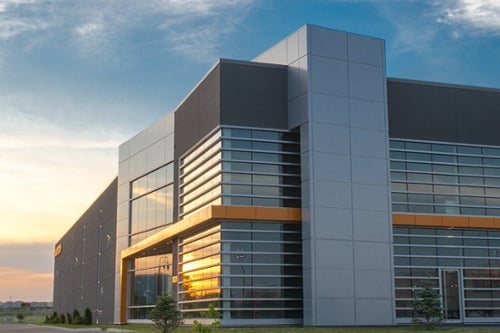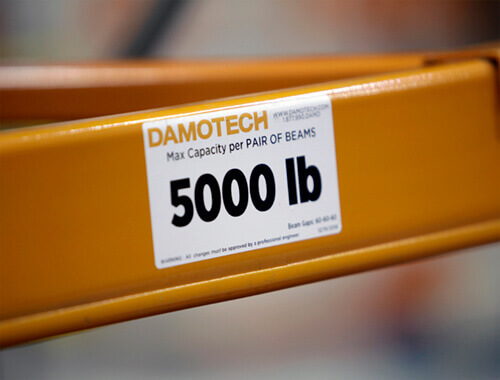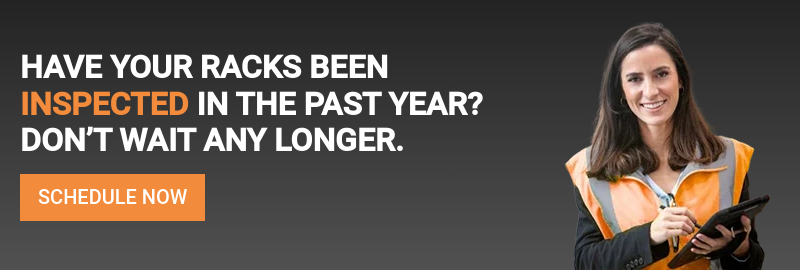Is your warehouse maximizing safety and efficiency? Pallet racking systems are the backbone of many warehouses, but their safety can be compromised over time.
A qualified rack safety expert can help you identify potential problems before they become accidents, optimize your storage capacity, and ensure compliance with regulations. This blog post explores 12 key situations where the expertise of a rack safety professional becomes invaluable.
#1 Preliminary Rack Inspection
Ensuring a safe workplace for employees requires a thorough assessment of your pallet racking systems. Before making any changes, a baseline inspection by a qualified rack inspector is crucial.
This inspection provides a clear picture of the current condition of your racks, helping to identify potential safety hazards and ensure compliance with industry standards. It also creates a valuable reference point for tracking the progress of any safety issues over time.
During the baseline inspection, the rack inspector will meticulously examine your entire racking system, collecting data, capturing images, and documenting any deficiencies, damage, or missing components. This detailed report allows you to prioritize repairs and implement necessary safety measures to prevent accidents and costly downtime. Ideally, these inspections are designed to be minimally disruptive to your daily warehouse operations.
#2 Annual Inspection
Regular check-ups, called compliance inspections, are essential to catch any sneaky new damage to your racks. Think of them as annual physicals for your warehouse—a chance to identify any emerging issues and ensure everything is running smoothly.
These inspections, typically conducted by independent rack experts or engineers, act as a progress report on your rack’s health. They’ll spot new damage and monitor the resolution of reported issues. Detailed reports from these check-ups empower you to take corrective action and keep your racks in tip-top shape, ensuring continued compliance with safety standards.
#3 Incomplete Racking Documentation
Do you have all the necessary documentation for your racking systems, including current Load Application and Rack Configuration (LARC) drawings?
Layouts with rated load capacities are mandatory. North American guidelines and standards require pallet rack owners to showcase the load capacity limits of their racking systems and make updated drawings available to health and safety officials. LARC drawings are essential for adhering to building codes set by state, county, and local jurisdictions.
But it’s not just about paperwork. Imagine a forklift operator overloading a rack because they can’t find the weight limit. That’s why clear load capacity labels or plaques are crucial. Think of them as friendly reminders for your forklift drivers, keeping everyone safe. These labels can even be placed strategically, like at the end of the aisles, for a quick weight limit check.
Beyond preventing overloading, load capacity displays facilitate regular safety inspections. They help rack inspectors identify any potential trouble spots before things get out of hand.
An experienced engineer can ensure everything is up-to-date and your racks are properly labeled. It’s a small investment for a big return on safety and peace of mind!
#4 After Modifying your Racking Configuration
Warehouses often undergo changes, and you might be tempted to modify specific rack configurations over time to better suit your needs.
However, the modifications could differ from the LARC drawings. Modifying your rack systems, like adjusting beam height or replacing components with different specifications, requires an inspection or certification before the racks can be put back into use.
According to the Rack Manufacturers Institute (RMI), it’s crucial to consult the LARC drawings and a certified rack engineer before any changes. If the new configuration is safe, collaborate with your Original Equipment Manufacturer (OEM) or a qualified rack engineer to create updated LARC drawings. Supported by structural calculations, these drawings confirm the safety of your modifications. The engineer will then recalculate the system’s capacity and update the load plaques/labels to reflect the new weight limit.
Another common pitfall is replacing damaged uprights without checking compatibility. Even slight differences in steel gauge (thickness) can significantly affect load capacity and lead to collapse. The same goes for beams—mismatched components can compromise lateral stability and lead to dislodging.
When uncertain, always contact your OEM or a rack inspector to ensure the compatibility of replacement parts.
#5 After a Seismic Event or Rack Collapse
Has an incident occurred in your warehouse, either due to human error, like a forklift accident, or a natural cause, like an earthquake? In such situations, professional rack inspection services are essential.
Following a major incident such as a collapse or earthquake, it’s essential to verify the integrity of your racks to ensure they haven’t been compromised. Before clearing the aisles, have your racks’ condition evaluated to determine if they can still support potential aftershocks.
Earthquakes can induce stress and damage to your racking systems, resulting in issues like pulled anchors, out-of-plumb upright columns, deformed bracing components, and deformed beam-to-column connectors. Certain city regulations, such as those in Colorado and California, mandate an engineer’s post-earthquake assessment of racks before resuming rack operations. Check local standards to be well prepared for earthquake-related incidents.
#6 After Repairing or Replacing a Rack
After repairing damaged racks, verifying they still meet original specifications and maintain their rated load capacity is crucial for the safety and integrity of your entire system. If a specialized repair kit or replacement parts were used, have your Load Application and Rack Configuration (LARC) drawings updated accordingly.
According to RMI, these updated drawings should include details like the size of replacement columns, splice positions, frame bracing changes, and any modifications made to anchorage or baseplates.
#7 After Installing New Pallet Racking Systems
Hiring a third-party rack inspector to verify proper installation is an investment that pays off. Rack inspectors ensure your racks are set up according to the manufacturer’s plans and meet industry standards.
This meticulous inspection helps prevent potential safety hazards and inefficiencies, guaranteeing the structural integrity of your racks from the very beginning. The result? A safer and more efficient warehouse environment for everyone.
#8 Evaluating the Effectiveness of Rack Safety Measures
Before launching a safety initiative, a thorough rack inspection by an expert provides a critical baseline assessment. This initial snapshot helps you identify areas of concern and track progress as you implement safety improvements.
Managing multiple warehouses? A rack specialist ensures consistent and accurate evaluations across all locations. This allows you to efficiently pinpoint facilities that need extra attention.
Third-party inspections become a valuable tool for benchmarking rack safety performance. By comparing your internal processes with expert findings, you gain a clear picture of effectiveness and can make data-driven decisions on the next steps. This benchmarking helps identify areas for improvement and ensures consistent adherence to safety standards across your entire operation.
#9 Before/After a Safety Audit or Preparing for OSHA’s Visit
Before or after a regulatory or corporate audit, enlist a professional for a comprehensive report on your pallet rack compliance. This report verifies certification status and summarizes inspection findings, keeping you informed.
A thorough third-party inspection is also highly advisable before the OSHA certification process. It guarantees that your pallet rack systems adhere to OSHA requirements and are certified to meet safety standards.
Additionally, given the implementation of OSHA’s NEP for warehouses and distribution centers, it is recommended to seek expert assistance to ensure your warehouse aligns with OSHA requirements. Third-party rack inspectors will help confirm that your warehouse is well prepared for an OSHA visit, effectively addressing compliance needs and safety standards.
#10 Before Renting or Purchasing a Warehouse
Before leasing or buying a warehouse, a thorough inspection by a specialized rack safety professional is essential. Just like the building itself, the condition of the racking systems significantly impacts your investment. This expert assessment reveals the current state of the racks, including any potential problems.
Rack experts will also provide key insights into the cost of repairs or upgrades needed to bring the system up to industry standards and safety regulations. This information empowers you to make informed decisions about the overall cost and potential liabilities associated with the warehouse.
#11 Streamlining Warehouse Operations and Safety
If you aim to enhance warehouse rack safety and optimize the performance of your racking systems, seek guidance from experienced engineers specializing in racking systems. These professionals possess the knowledge to provide expert advice on maximizing operational efficiency and minimizing the risk of incidents.
#12 Before a Regulatory Review for Rack Safety
Certain jurisdictions may demand official paperwork, such as a Pre-start Health and Safety Review (PSR). These documents certify that your pallet racks have undergone an inspection and are deemed safe for use. For instance, the Ministry of Labour in Ontario mandates a PSR, while WorkSafeBC in British Columbia stipulates regular inspections to uphold safety standards.
According to OSHA regulations, employers must regularly inspect storage racks and promptly replace or repair any damaged or weakened components. Regardless of local regulations, conducting routine pre-use checks is a widely recognized best practice to ensure rack safety and prevent potential hazards.
Conclusion: The Crucial Role of Rack Inspectors in Warehouse Operations
Throughout a warehouse’s lifecycle, consulting a rack safety expert at key junctures is a strategic investment. These professionals safeguard your employees, prevent costly accidents, and ensure smooth operations by verifying compliance and maximizing rack system effectiveness.
Regular inspections by a qualified rack inspector are an extension of this proactive approach. They identify potential issues before they escalate, protect your warehouse environment, and keep your workers safe.
For enhanced efficiency, consider the Damotech Platform. This cloud-based system allows you to conveniently monitor real-time rack health and access inspection reports. Watch our demo video to see how Damotech can revolutionize your warehouse safety strategy!










